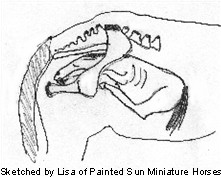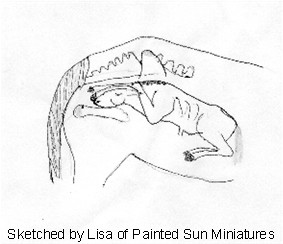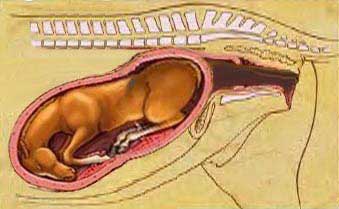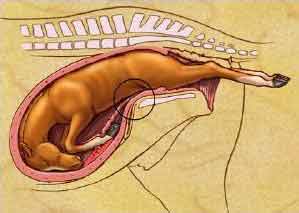
Instead of the normal two front feet and a nose, there will be 3 front feet and a nose. The first thing you have to do is figure out which leg is the back leg. Put hand in and feel for hocks or run hand down foal’s front legs to find chest.
Once you find the back foot, put two fingers behind pastern/ankle try to LIFT HOOF over pelvic rim while your helper pushes foal back. As soon as you feel any movement or release, slide your hand with palm upwards and catch the sharp hoof tip as it falls, protecting the mare’s uterus
7. Forelegs over head/ears

Foal will be coming out, except for that the hooves will be on top of the nose instead of the nose on top of the hooves. Lube well and go in with your palm towards the center
Once you locate the knees, which will be hooked over the ears, gently lift legs from head into normal position
Presentations to CALL THE VET
In the following presentations, while waiting for the vet to arrive, walk the mare slowly around the stall. A mare can’t push and walk at the same time. Have your trailer hooked up, deeply bedded and ready to haul her in.
1. Full Breech (Backwards with no legs coming)
You will see a tail and a butt and no legs, emergency!
Breech

After scrubbing and lubing, palpate your mare. Remember in some cases the mare's water will not have broken yet. After feeling around it will be apparent why if you have the rear end of the foal plugging the cervix and pelvic opening.
Get your mare standing. Sometimes mares will not cooperate, however, if the mare stands, the foal and all of the mare's weight tends to pull away from the cervix and pelvic opening.
Tear the placental sac covering the foal’s rump as it protrudes through the cervix as in the case of a red bag delivery. The hindquarters of the foal will be pressed tightly against the cervical opening like a stopper and very little water may be released even when the placenta is torn.
Now picture your foal in your head. Pass your hand through the hole made in the placenta and you should feel the smooth, amniotic sac containing the foal. You should feel the tail. While you can try to manipulate baby through the amniotic sac you can also rupture the sac to actually be touching baby and have baby’s butt in your hand. IF you rupture the sac at this stage, be prepared to move quickly and smoothly through the following steps.
Follow the butt down to the legs. You should be able to determine how baby is standing or laying -- in this presentation many times baby will be in the same position as the mother.
Now you have 2 legs in the birth canal. Once the body of the foal enters the vagina, its blood supply will most likely be shut off. This is due to the umbilical cord being flattened by the pressure of the foal's body against the wall of the vagina. In this presentation the foal's head will be immersed in amniotic fluid in the uterus. Once the umbilical cord is pinched off, no oxygen will get to the body. If the delivery is not quick, brain damage is of immediate concern and, of course, the life of the foal and also the mare was at risk.

Foal backwards, hocks first, umbilical cord will become compressed against pelvic brim, can cause suffocation or oxygen deprivation
Grab the rear legs and pull forcefully as the mare contracts. Once in the feet back position, the foal should be delivered easily pulling with the mare’s contractions.
2. Upside Down Breech (backwards & upside down)
It will look like a full breech, but with the tail on the bottom
3. Back (spine) of foal first, also called transverse
Mare will be pushing…nothing coming, you stick your hand in, and hit a solid wall of foal, the foal’s back.
4. All 4 feet coming at same time, another transverse
If you are confronted with any one of the aforementioned problems, the first thing to remember is do not panic. Call your vet.
If you are confident enough you may also try to resolve the situation yourself as many of us do, because of lack of access to a vet. Some of these malpositions -- or dystocias, as they are called -- are common in the world of foal deliveries, and this informaion is presented only to help give some basic steps that can be taken to help get baby safely to the ground.
Keep in mind that your vet is going to try to resolve the situation by manually repositioning the foal in order for it to be delivered successfully. Many of us over the years have called the vet for assistance, and then taken the steps provided. It is better to have called the vet and have him arrive to find baby safely on the ground, than to wait too long to call him, and compromise baby's "window of opportunity" to survive.
Things to do while waiting for the vet to arrive: The first and most important thing is to get the mare up if she is lying down and get her moving. This will stop contractions and assist the foal to slip back into the uterus making the repositioning task easier. If you have a person to assist you and your mare is quiet, one can lead the mare while the other walks behind the mare with a gloved hand/arm inserted in the birth canal and put pressure on the foal to aid its retreat. If you feel confident to this point you can feel for the foals forelegs and head and reposition them yourself. If not, keep the mare calm and moving and wait for your vet.
Be sure to only do as much as you genuinely feel confident with, that's why we depend on and pay vets the big bucks. Equine Medical Service
-----------------------------------------------------------------------------------------------------------
After foaling make sure that the placental membrane is entire - spread the membrane out on the ground, there should be one large tear where the foal emerged. Any pieces missing my be retained inside the mare causing severe infection and blood poisoning. Your mare will display colic symptoms and a rapid rise in temperature in the next few days if this is the case. The membrane should be a healthy pink colour, a green or yellow cast can indicate placentitis, and brown muck means that the foal has passed some meconium during the birthing process, usually a sign of a protracted or difficult labour. If the membranes are turned inside out a red bag delivery is very likely. Sometimes it can take a while for the mare to pass the membrane - never pull the membrane from the mare as this can tear it or cause her to hemorrhage. If it is dragging on the ground or tangling her legs it can be tied up into a ball with twine.
The mare that retains its placenta must be monitored for passage of the placenta, and then treated appropriately to prevent complications. Call your veterinarian should you have a retained placenta, as this can be dangerous situation for your mare. Additionally all mares must be observed for such complications as rupture of an internal artery, large colon torsion and laminitis. Continued sweating, reduced interest in the foal, and persistent colic indicate a problem in the mare. Mild colic from uterine contractions is normal after foaling, but not severe or persistent colic. The mare may be normal just after foaling but then may begin to sweat and show colic. Hot feet and constant shifting of weight, usually beginning 24 hours after foaling or later, indicate laminitis.
Post Foaling Complications: I recommend that all mares and their foals receive a post foaling examination and that you consult your veterinarian in advance as to the timing of this exam.
If you have any questions concerning foaling and foaling problems you should consult with your veterinarian. If you know in advance that you are not prepared to handle the possibility of a foaling emergency, you should talk to your veterinarian about options for having the mare deliver her foal in a foaling facility that is equipped to handle these situations.
-----------------------------------------------------------------------------------------------------------